The Just Cause franchise inhabits an interesting corner of the video game scene. It’s one of the largest environments on the market and packed with collectibles, but Just Cause maintains its appeal by providing the tools to perform stunts that rival Hollywood’s best performers. And, let’s be honest, who wants to visit sync points or track down audio logs when they could be launching a convertible hundreds of meters through the air or riding a flaming gas canister off into the sunset?
Not much has changed in Just Cause 3. The game still focuses on the adventures of Rico Rodriguez; a CIA spy who was born in Mexico, later moving to the fictitious country of Medici with his mother, before being recruited into the agency as a young man. There’s a 25-mission campaign, which sees Rico looking to topple the government of Sebastiano Di Ravello who has assumed control of Rodriguez’s childhood home.
Gameplay is still pretty much the same. Using a combination of air, land and sea vehicles, plus a wingsuit and parachute, players lead Rodriguez from one settlement to the next. It’s pretty much exactly what we’ve come to expect: Rico bathes the country in the fires of freedom (and exploding fuel tanks) by destroying anything with the distinct red paint that identifies destructible elements of the environment. Most importantly, the backbone of the Just Cause gameplay experience is still liberating cities and towns from the control of a madman.
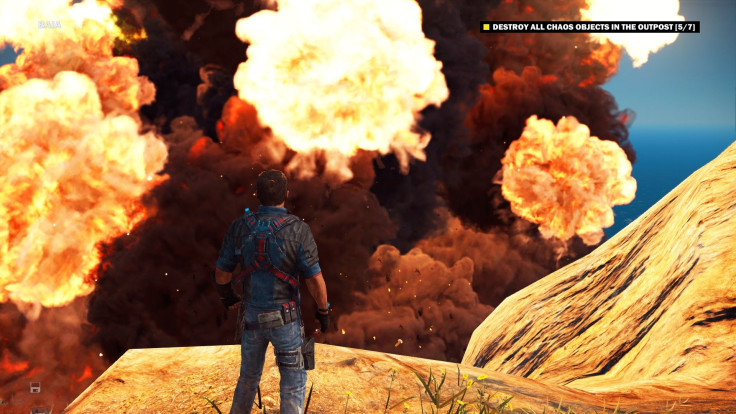
In addition to helping advance the narrative, liberated settlements offer a variety of benefits to the player. Many are home to a garage/chop-shop where Rico can dismantle stolen vehicles. Once they’ve been chopped the vehicles can be delivered anywhere on the map. Rico will also liberate airfields and docks, gaining access to boats, helicopters and planes. Police stations let players replenish ammo and random encounters unlock additional resupply points and churches where Rico can lose his Heat, Just Cause’s take on the Wanted meter.
But those loyal to Medici’s totalitarian leader aren’t going to sit idly by while you destroy symbols of the beloved leader. While travel is mostly uninhibited, provided you don’t attempt to enter government-only facilities, military forces will scramble when Rico destroys Chaos objects – the game’s designation for fuel tanks, billboards and other symbols of Di Ravello’s government – or firing his weapon near/at government forces. A Heat meter keeps track of the government’s current attempts to quell Rodriguez actions and soldiers will occasionally attempt to call in reinforcements. Failure to kill them before the call goes through will increase the Heat on Rico.
Along the way, players will also unlock a variety of optional challenges, each focused on a specific aspect of the Just Cause gameplay experience. There are wingsuit courses, shooting galleries, explosive-rigged vehicles that can’t dip below certain speeds and all manner of other adrenaline-inducing activities. The challenges serve two purposes. First, challenges unlock improved equipment (called Gear Mods) for Rico to use in his fight against Di Ravello. Second, leaderboards for each challenge give Just Cause 3 players an extra incentive to improve their performance on each course.
Rebel Drops offer a new resupply system that calls for beacons (instead of cash) when Rico finds himself in needs of more supplies. Just Cause 3 also features a slightly more robust fast travel system than its predecessor, but fast travel still isn’t available in combat and can only be used if/when players have flares in their inventory. Both flares and beacons can be refilled at certain places, like bases and convenience stores, throughout Medici.
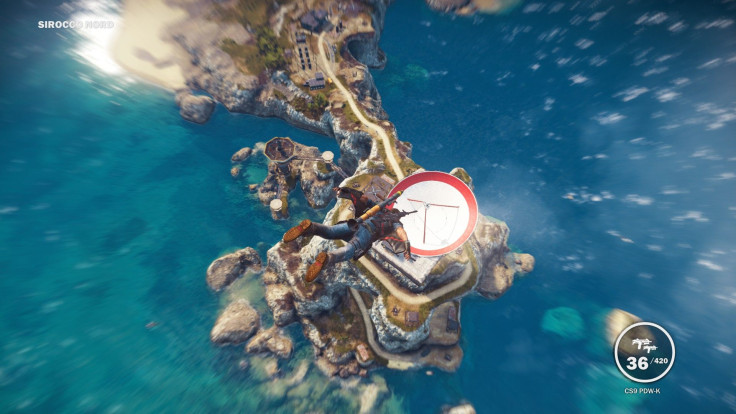
Collectibles also play a more manageable role than we’ve previously seen from the franchise thanks to some restraint on the part of the devs. Previous iterations featured hundreds of parts, many of which were incorporated into the liberation process. Thankfully, things are a bit different in Just Cause 3. The game still features five sets of collectibles – ancient tombs, audio logs, daredevil jumps, rebel shrines and vintage parts – but the numbers are a bit more manageable. Rounding up each confers a variety of perks, from new equipment to cost-free fast travel. Audio logs are the only exception but the tapes flesh out the story behind Di Ravello’s rise to power and the early years of Rico’s life.
And that’s pretty much Just Cause 3 in a nutshell. Once you finish the first few missions, the game sets you free in Medici. What comes next is entirely up to the player. The only caveat is that everything in Just Cause 3 is built around the liberation mechanic. Challenges are unlocked by liberating settlements. Collectibles aren’t shown on the map until you fully liberate a province. There are even missions that can’t be accepted until certain sites are liberated. This shouldn’t come as a surprise to franchise fans. But newcomers should know Just Cause 3 isn’t another open-world like The Witcher 3: Wild Hunt or Fallout 4.
Just Cause 3 features one of the biggest environments of any game to debut this year; including the previously mentioned Witcher and Fallout. In less than 50 hours I’ve hit 83 percent completion. There aren’t any side stories to unravel over the course of the Just Cause 3 campaign or a New Game Plus mode to dive into after your first run. There are a few small surprises to be found along the way but environmental storytelling doesn’t appear to have been priority. That said, I’m not sure players will ever really lack things to do in Just Cause 3.
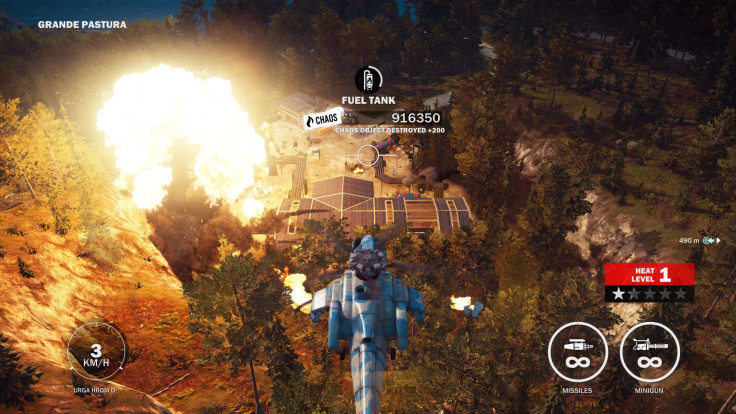
More than 120 settlements are waiting to be liberated, from small electrical facilities to the sprawling capital city of Medici, and a few hundred collectibles can be acquired along the way. And, if that’s not enough, a variety of leaderboards track all manner of feats – from consecutive bullets hitting an enemy to the distance Rico travels during a single ragdoll – and let the Just Cause 3 community compete to see who will become the most dangerous secret agent Medici has ever seen. Eventually, you’re even given the power to re-oppress settlements, making it easy to jump start the action wherever you’d prefer.
Just Cause 3 refines many aspects of the gameplay we’ve come to expect from the franchise. But my search for a five star release in 2015 continues due to shortcomings both major and minor. What might be most disappointing is how many of the issues are holdovers from the game’s five-year-old predecessor. As someone who spent an absurd amount of time with Just Cause 2, I remember all-too-vividly the frustration of clearing 90-plus percent of a settlement, only to spend 20 minutes trying to find the one fuel tank or weapon part that slipped under the radar.
Unfortunately, the JC3 team just doesn’t have a great solution to the problem. Avalanche added a bit more information to the map, via icons that represent remaining Chaos objects, but it’s not enough to eliminate the issue. I frequently found myself circling the same encampment over and over, trying to figure out what angle would reveal the transformer hidden below a metal grating or unnoticed terminal that needed to be activated. The problem is particularly noticeable in multi-tiered environments, like the handful of oil rigs found in Medici’s coastal waters.

On paper, the correlation between challenges and character progression sounds great. The idea is to reward players with improved versions of the experiences they already prefer. So completing plane challenges unlocks air travel gears, while trips to the shooting gallery unlock Gear Mods that improve Rico’s shooting abilities. The problem is that many of the Gear Mods unlocked over the course of Just Cause 3 don’t actually make Rico any more dangerous on the battlefield. Nitrous makes for an amusing distraction in between missions, particularly if you’re hunting down daredevil jumps, but it doesn’t have much use in the heat of battle. And some abilities locked behind the challenge system probably don’t belong there. I’m looking at you, Precision Aim.
It defies common sense, even for a video game, and can have the unintended consequence of leaving players unaware that the “feature” is present in Just Cause 3 at all. I’d actually spent close to 30 hours with the game before realizing I could earn enough gears to feel like I had significant control over where Rico was aiming. Similarly, I’m not a fan of the decision to gate the Fast Travel system, limiting its usage or using beacons and timers to regulate Rebel Drops. I realize things could start to break down pretty quickly without some of those mechanics in place. But that’s sort of the point. I don’t want to bludgeoned into using the same weapons over and over again. I want to create the kinds of absurd spectacles that I usually pay money to see in theaters.
The sheer amount of wasted space on the map, since there doesn’t appear to be anything in the ocean other than water, is also frustrating. Just Cause 3 might ship with the largest map of any game in the series but it felt like there was more to see/do in Just Cause 2. Yes, some of that reduction benefits the project, as I mentioned before. But the massive bodies of water in Just Cause 3 don’t serve much purpose other than extending the amount of time it takes you to travel from island to island. It also gives the AI an extra set of units, military boats, to shell your position from. But the massive bodies of water don’t feel like much of a benefit to the player.
Just Cause 3 delivers the most-approachable version of the series’ particular brand of mayhem. It’s over the top, from the very first minutes of the campaign until the final province is liberated, the game is easily one of the prettiest I’ve played all year. Avalanche continues to set the bar with its rendering of explosions. Cities can begin to look a bit cookie-cutter after a few hours but the various mountains, plains, hills and coastlines of Medici make for some of the best looking environments of the last few years.
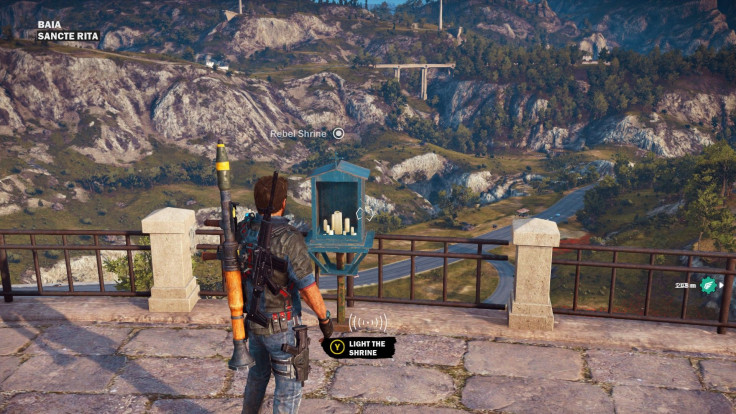
The game isn’t without its faults. The core gameplay loop can begins to feel a bit stale after a few hours. Hamstrung fast travel and resupply mechanics limit the action in ways that many will find pesky. And some of the content gated behind the game’s challenge systems should probably have just been available by default. But I suspect Just Cause 3 will stop being entertaining around the same time as big-budget action movies. And by that, I mean it’s never going to happen.
Just Cause 3 might not be the game you play on a daily basis. Once you’ve finished the campaign, it might not even be a weekly basis. But, like its predecessor, Just Cause 3 feels like a game that I’ll be returning to for years to come. It’s the kind of game that manages to feel both familiar and new. Longtime fans will be able to dive back in without issue. Those coming to the series for the first time will find the most-polished version of Just Cause waiting for them. Either way, there's really not much to be mad at.
The changes present in Just Cause 3 aren’t substantial enough to win over those uninterested in the game’s predecessors. But there’s more than enough here for longtime fans to justify one last $60 purchase before the end of 2015.
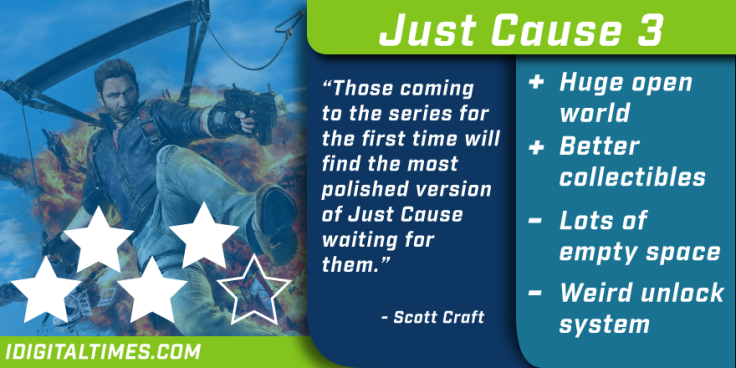
Full Disclosure: The PC copy of Just Cause 3 used for this review was provided by a representative of Square Enix; however, neither the publisher nor the game’s developer, Avalanche Studios, retained any editorial oversight/privileges.
Be sure to check back with iDigitalTimes.com and follow Scott on Twitter for more Just Cause 3 coverage throughout the rest of 2015 and for however long Avalanche Studios continues to support Just Cause 3 in the months following launch.


















